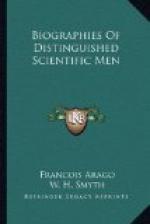It is not only relative to the comparative merit of single or double eye-pieces that Herschel differs from the general opinions of opticians; he thinks, moreover, that he has proved by decisive experiments, that concave eye-pieces (like that used by Galileo) surpass the convex eye-piece by a great deal, both as regards clearness and definition.
Herschel assigns the date of 1776 to the experiments which he made to decide this question. (Philosophical Transactions, year 1815, p. 297.) Plano-concave and double concave lenses produced similar effects. In what did these lenses differ from the double convex lenses? In one particular only: the latter received the rays reflected by the large mirror of the telescope, after their union at the focus, whereas the concave lenses received the same rays before that union. When the observer made use of a convex lens, the rays that went to the back of the eye to form an image on the retina, had crossed each other before in the air; but no crossing of this kind took place when the observer used a concave lens. Holding the double advantage of this latter sort of lens over the other, as quite proved, one would be inclined, like Herschel, to admit, “that a certain mechanical effect, injurious to clearness and definition, would accompany the focal crossing of the rays of light."[20]
This idea of the crossing of the rays suggested an experiment to the ingenious astronomer, the result of which deserves to be recorded.
A telescope of ten English feet was directed towards an advertisement covered with very small printing, and placed at a sufficient distance. The convex lens of the eye-piece was carried not by a tube properly so called, but by four rigid fine wires placed at right angles. This arrangement left the focus open in almost every direction. A concave mirror was then placed so that it threw a very condensed image of the sun laterally on the very spot where the image of the advertisement was formed. The solar rays, after having crossed each other, finding nothing on their route, went on and lost themselves in space. A screen, however, allowed the rays to be intercepted at will before they united.
This done, having applied the eye to the eye-piece and directed all his attention to the telescopic image of the advertisement, Herschel did not perceive that the taking away and then replacing the screen made the least change in the brightness or definition of the letters. It was therefore of no consequence, in the one instance as well as in the other, whether the immense quantity of solar rays crossed each other at the very place where, in another direction, the rays united that formed the image of the letters. I have marked in Italics the words that especially show in what this curious experiment differs from the previous experiments, and yet does not entirely contradict them. In this instance the rays of various origin, those coming from the advertisement and from the sun, crossed each other respectively in almost rectangular directions; during the comparative examination of the stars with convex and with concave eye-pieces, the rays that seemed to have a mutual influence, had a common origin and crossed each other at very acute angles. There seems to be nothing, then, in the difference of the results at which we need to be much surprised.




